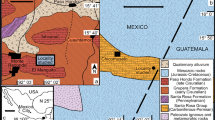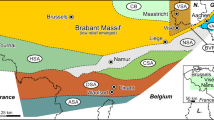Abstract
The oribatid mite assemblages found in late-glacial and early-Holocene sediments in Kråkenes Lake, western Norway, consist of 38 species within 24 genera. In accordance with known present habitat distribution we distinguish 4 true aquatic species, 6 species associated with wetland, 2 with mesic grassland, 12 with dry grassland and heathland, 3 with saxicolous and arboricolous lichens, 7 widely distributed species, and 4 with uncertainly known habitat preferences. The sediments from the pioneer phase (12,300-11,700 14C BP) contain 7 species, among them the 2 typical pioneer species Limnozetes ciliatus and Tectocepheus velatus.
The sediments of the warmer Allerød interstadial (11,700-10,900 BP) contain 18 species, the cold Younger Dryas (10,900-10,000 BP) 9 species, and the early Holocene (10,000-9,000 BP) 36 species.
The oribatid fossils of the pioneer phase indicate habitats and climate similar to the mid-alpine zone in western Norway today, the Allerod interstadial that of the low- to mid-alpine zone. L. ciliatus is the aquatic pioneer species in the Allerod. In the Younger Dryas the climate was more arctic, 60-70% of the species had presumably disappeared, and no aquatic species were found. In the early Holocene, 4 true aquatic species colonised the lake and showed a high productivity. The terrestrial oribatid fauna in this period contained a high diversity of more boreal species, while the alpine species declined or became extinct.
Similar content being viewed by others
References
Birks, H. H., 2000. Aquatic macrophyte vegetation development in Kråkenes Lake, western Norway, during the late-glacial and early-Holocene. J. Paleolim. 23: 7–19.
Birks, H. H., Aa. Paus, J. I. Svendsen, T. Alm, J. Mangerud & J. Y. Landvik, 1994. Late Weichselian environmental change in Norway, including Svalbard. J. Quat. Sci. 9: 133–145.
Birks, H. H. & 23 others, 1996. The Kråkenes late-glacial palaeoenvironmental project. J. Paleolim. 15: 281–286.
Birks, H. H., R. W. Battarbee & H. J. B. Birks, 2000. The development of the aquatic ecosystem at Kråkenes Lake, western Norway, during the late-glacial and early-Holocene — a synthesis. J. Paleolim. 23: 91–114.
Birks, H. H. & H. E. Wright, 2000. Introduction to the reconstruction of the late-glacial and early-Holocene aquatic ecosystems at Kråkenes Lake, Norway. J. Paleolim. 23: 1–5.
Brooks, S. J., 1997. The response of Chironomidae (Insecta: Diptera) assemblages to late-glacial climatic change in Kråkenes Lake, western Norway. Quat. Proc. 5: 49–58.
Brooks, S. J. & H. J. B. Birks, 2000. Chironomid-interferred lateglacial and early-Holocene mean July air temperatures for Kråkenes Lake, western Norway. J. Paleolim. 23: 77–89.
Dalenius, P., 1960. Studies on the Oribatei (Acari) of the Torneträsk territory in Swedish Lapland. I. A list of the habitats and the composition of their oribatid fauna. Oikos 11: 80–124.
Dalenius, P., 1962. Studies on the Oribatei (Acari) of the Torneträsk territory in Swedish Lapland. III. The vertical distribution of the moss mites. Kungl. Fysiograf. Sä llsk. Lund Forh. 32, 10: 105–129.
Drouk, A. Y., 1997. Acarological analysis: Problems of palaeoecological reconstructions. In Edwards, M. E., A. V. Sher & R. D. Guthrie (eds), Terrestrial Palaeoenvironmental Studies in Beringia: 91–97.
Erickson, J. M., 1988. Fossil oribatid mites as tools for Quaternary paleoecologists: preservation quality, quantities, and taphonomy. In Laub, R. S., N. G. Miller & D. W. Steadman (eds), Late Pleistocene and Early Holocene Paleoecology and Archaeology of the Eastern Great Lakes Region. Bull. Buffalo Soc. Nat. Sci. 33: 207–226.
Gjelstrup, P. & T. Solhøy, 1994. Oribatid mites (Acari). In The Zoology of Iceland. Steenstrupia 3, 57: 1–78.
Grimm, E. C., 1990. TILIA and TILIA.GRAPH, PC spreadsheet and graphics software for pollen data. INQUA Working Group on Data Handling Methods Newsletter, 4: 5–7.
Gulliksen, S., H. H. Birks, G. Possnert & J. Mangerud, 1998. A calendar-age estimate of the Younger Dryas — Holocene boundary at Kråkenes, western Norway. The Holocene 8: 249–259.
Jonsgard, B. & H. H. Birks, 1995. Late-glacial mosses and environmental reconstructions at Kråkenes, western Norway. Lindbergia 20: 64–82.
Karppinen, E., 1971. Studies on the Oribatei (Acari) of Norway. Ann. Ent. Fenn. 37: 30–53.
Karppinen, E., D. A. Krivolutsky, M. Koponen, L. S. Kozlovskaja, L. M. Laskova & M. Viitasaari, 1979. List of subfossil oribatid mites (Acarina, Oribatei) of northern Europe and Greenland. Ann. Entomol. Fenn. 45: 103–108.
Krivolutsky, D. A. & A. Y. Druk, 1986. Fossil oribatid mites. Ann. Rev. Entomol. 31: 533–545.
Krivolutsky, D. A., A. Y. Druk, I. S. Eitminavichyute, L. M. Laskova & E. Karppinen, 1990. Fossil oribatid mites. Mokslas Publishers Vilnius: 109 pp.
Laakso, J., J. Salminen & H. Setälä, 1995. Effects of abiotic conditions and microarthropod predation on the structure and function of the soil animal communities. Acta Zool. Fennica 196: 162–167.
Larsen, E. & O. Longva, 1979. Jordartskartlegging, glasialgeologi og kvartæ r stratigrafi på Stad og Vågsøy, ytre Nordfjord. Thesis, University of Bergen.
Larsen, E., F. Eide, O. Longva & J. Mangerud, 1984. Allerød — Younger Dryas climatic inferences from cirque glaciers and vegetational development in the Nordfjord area, western Norway. Arct. Alp. Res. 16: 127–160.
Lindegaard, C., 1992. Zoobenthos ecology of Thingvallavatn: vertical distribution, abundance, population dynamics and production. Oikos 64: 257–304.
Lundquist, L., 1987. Bibliografi och checklist över Sveriges oribatider (Acari: Oribatei). Ent. Tidskr. 108: 3–12.
Luxton, M., 1990. Oribatid mites from Holy Island. Transactions of the National History Society of Northumbria 55, 2: 144–146.
Mangerud, J., 1987. The Allerød/Younger Dryas boundary. In Berger, W. H. & L. D. Labeyrie (eds), Abrupt Climatic Change. D. Reidel, Dordrecht: 163–171.
Mangerud, J., E. Larsen, O. Longva & E. Sønstegaard, 1979. Glacial history of Western Norway 15,000–10,000 B.P. Boreas 8: 179–187.
Marshall, V. G., R. M. Reeves & R. A. Norton, 1987. Catalogue of the Oribatida of continental United States and Canada. Mem. Entomol. Soc. Canada 139: 1–418.
Mehl, R., 1979. Checklist of Norwegian ticks and mites (Acari). Fauna Norvegica Ser. B 26: 31–45.
Niemi, R., 1988. Oribatid mites (Acarina, Oribatei) new to the Finnish fauna. Notulae Entomol. 68: 111–113.
Niemi, R., E. Karppinen & M. Uusitalo, 1997. Catalogue of the Oribatida (Acari) of Finland. Acta Zool. Fennica 207: 39 pp.
Schelvis, J., 1990. The reconstruction of local environment on the basis of remains of oribatid mites (Acari; Oribatida). J. Archaeol. Sci. 17: 559–571.
Schelvis, J. & B. van Geel, 1989. A palaeoecological study of the mites (Acari) from a Late-glacial deposit at Usselo (The Netherlands). Boreas 18: 237–243.
Solhøy, I. W. & T. Solhøy, 1997. Limnic Oribatid mites in lateglacial and early Holocene sediments in Kråkenes Lake, Western Norway. Würzburger Geograph. Manuskr. 41: 235–236. 7th Intern. Symp. Palaeolimn. Germany 1997.
Solhøy, T., 1975. Dynamics of Oribatei populations on Hardangervidda. In: Wielgolaski, F. E. (ed.), Fennoscandian Tundra Ecosystems. Part 2. Ecological Studies 17: 1–337.
Solhøy, T., 1976. Species composition of Oribatei (Acari) on oceanic mountain ground in western Norway. Norw. J. Ent. 23: 17–22.
Solhøy, T., 1979. Oribatids (Acari) from an oligotrophic bog in western Norway. Fauna Norvegica Series B 26: 91–94.
Solhøy, T. & D. O. Øvstedal, 1981. Planter, plantesamfunn og dyr på et forsøksfelt med nærliggende omgivelser på Rebnor, Austrheim herred, Hordaland. Lindås prosjektet, rapport 30, Zool. Mus. og Bot. Inst., Bergen, 83 pp.
Strenzke, K., 1952. Untersuchungen über die Tiergemeinschaften des Bodens: Die Oribatiden und ihre Synusien in den Böden Norddeutschlands. Zoologica 104: 173 pp.
Tyynismaa, M., 1988. Oribatidi-punkkien habitaatin valinta laboratoriokokeessa. Jyväskylän yliopisto, Biologian laitos, Ekologian ja ympäristöhoidon pro gradu-tutkielma: 1–35.
Author information
Authors and Affiliations
Rights and permissions
About this article
Cite this article
Solhøy, I.W., Solhøy, T. The fossil oribatid mite fauna (Acari: Oribatida) in late-glacial and early-Holocene sediments in Kråkenes Lake, western Norway. Journal of Paleolimnology 23, 35–47 (2000). https://doi.org/10.1023/A:1008068915118
Issue Date:
DOI: https://doi.org/10.1023/A:1008068915118




